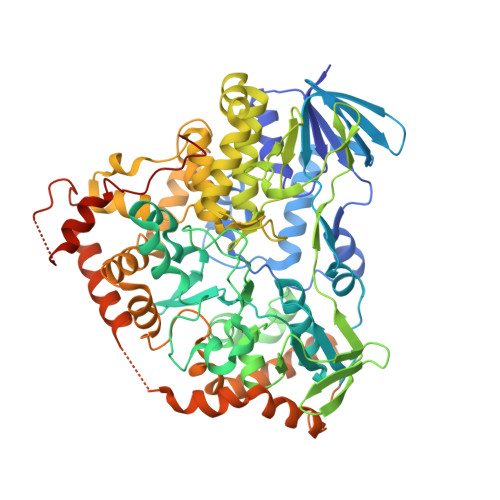Structural and functional insights into the self-sufficient flavin-dependent halogenase.
Dai, L., Li, H., Dai, S., Zhang, Q., Zheng, H., Hu, Y., Guo, R.T., Chen, C.C.(2024) Int J Biol Macromol 260: 129312-129312
- PubMed: 38216020
- DOI: https://doi.org/10.1016/j.ijbiomac.2024.129312
- Primary Citation of Related Structures:
8JZ2, 8JZ3, 8JZ4, 8JZ5 - PubMed Abstract:
Flavin-dependent halogenases (FDHs) have tremendous applications in synthetic chemistry. A single-component FDH, AetF, exhibits both halogenase and reductase activities in a continuous polypeptide chain. AetF exhibits broad substrate promiscuity and catalyzes the two-step bromination of l-tryptophan (l-Trp) to produce 5-bromotryptophan (5-Br-Trp) and 5,7-dibromo-l-tryptophan (5,7-di-Br-Trp). To elucidate the mechanism of action of AetF, we solved its crystal structure in complex with FAD, FAD/NADP + , FAD/l-Trp, and FAD/5-Br-Trp at resolutions of 1.92-2.23 Å. The obtained crystal structures depict the unprecedented topology of single-component FDH. Structural analysis revealed that the substrate flexibility and dibromination capability of AetF could be attributed to its spacious substrate-binding pocket. In addition, highly-regulated interaction networks between the substrate-recognizing residues and 5-Br-Trp are crucial for the dibromination activity of AetF. Several Ala variants underwent monobromination with >98 % C5-regioselectivity toward l-Trp. These results reveal the catalytic mechanism of single-component FDH for the first time and contribute to efficient FDH protein engineering for biocatalytic halogenation.
Organizational Affiliation:
State Key Laboratory of Biocatalysis and Enzyme Engineering, Hubei Hongshan Laboratory, Hubei Collaborative Innovation Center for Green Transformation of Bio-Resources, Hubei Key Laboratory of Industrial Biotechnology, School of Life Sciences, Hubei University, Wuhan 430062, PR China.
















